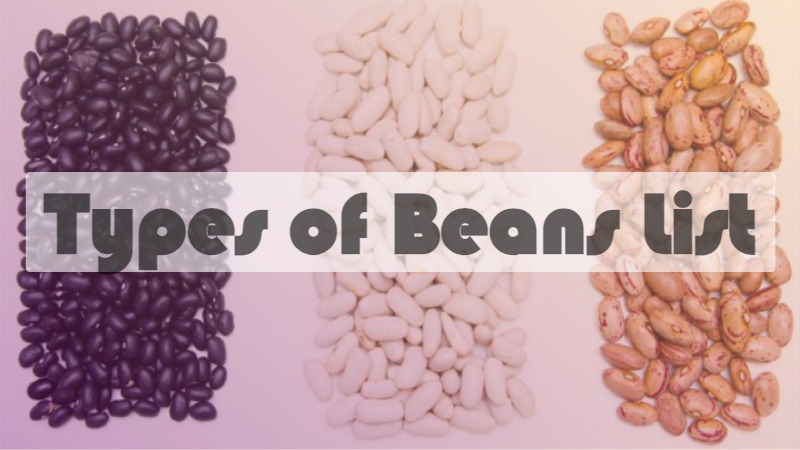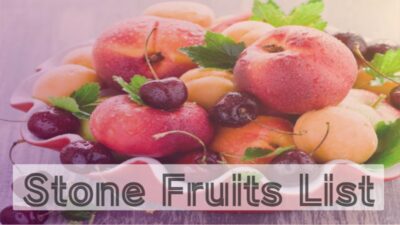
Types of Beans list with names of most commonly used beans, check 25 most popular and different types of beans to cook and plant with. Beans are a type of legume, which are edible seeds or pods from plants in the Fabaceae family. They are a versatile and nutritious food source consumed worldwide. Beans come in various shapes, sizes, colors, and flavors, offering a wide range of culinary possibilities.
Beans are highly regarded for their nutritional value. They are an excellent source of plant-based protein, dietary fiber, vitamins (such as folate, thiamine, and vitamin B6), minerals (such as iron, potassium, and magnesium), and antioxidants. They are also low in fat and cholesterol.
Common types of beans include kidney beans, black beans, pinto beans, navy beans, chickpeas (garbanzo beans), lentils, soybeans, cannellini beans, and many others. Each variety has its own distinct characteristics, flavor profile, and culinary uses. All beans are legumes but all legumes are not beans.
List of 25 Types of Beans
- Kidney Beans / Red Beans: The kidney beans are large and kidney-shaped, often used in chili, soups, and salads. Red beans are small in size, oval in shape and have the characteristic ruby-colored skin. They have a mild flavor, earthy, slightly sweet and nutty, and soft texture. Often used in Caribbean, Latin, Cajun, and Creole cuisine. It’s great for soups, chilis, and dishes like red beans and rice.
- Black Beans: Small and black in color, these beans are commonly used in Latin American cuisine, including dishes like black bean soup and rice and beans.
- Navy Beans / Haricot Beans: Also known as haricot beans, these small, white beans are often used in baked beans, soups, and stews.
- Pinto Beans: These medium-sized, speckled beans are commonly used in Mexican cuisine, particularly in dishes like refried beans and burritos.
- Chickpeas / Garbanzo Beans: Chickpeas are round and beige in color. They are widely used in Mediterranean and Middle Eastern cuisine, such as hummus and falafel.
- Fava Beans / Broad Beans: Fava beans, also known as broad beans, are large, flat beans with a green outer pod that is not typically eaten. Fava beans have a distinct earthy flavor and a creamy texture when cooked.
- Soyabean: Soybeans are small, round beans with a beige or yellow color. They have a high protein content, making them a valuable source of plant-based protein. Soybeans are also rich in essential amino acids, dietary fiber, healthy fats, vitamins, and minerals.
- Anasazi Beans: Anasazi beans are a type of bean that is named after the Anasazi Native American tribe, who are believed to have cultivated these beans centuries ago. Anasazi beans are medium-sized beans with a mottled pattern of burgundy and white speckles. When cooked, they retain their vibrant color and firm texture.
- Cranberry Beans / Borlotti Beans: Cranberry beans, also known as borlotti beans, are medium-sized beans with a thin skin and a creamy texture when cooked. They have a slightly nutty and mild flavor, which makes them versatile and suitable for various culinary preparations.
- Great Northern Beans: Great Northern beans are versatile and can be used in a variety of dishes. They hold their shape well during cooking, making them suitable for soups, stews, casseroles, and salads. They are often used as a substitute for other white beans such as cannellini beans or navy beans.
- Butter Beans / Lima Beans: Butter beans, also known as lima beans, are a type of bean that is prized for its buttery texture and delicate flavor. Butter beans are typically pale green or white in color and have a large, flat shape. There are two main types of butter beans: baby butter beans, which are small and tender, and Fordhook butter beans, which are larger and more mature.
- Black Eyed Peas: They are named after their characteristic black eye-like spot on the beige or cream-colored bean. Black-eyed peas are not actually peas but beans.
- Yellow Eye Beans: Yellow Eye beans are native to New England in the United States and are particularly associated with traditional Northeastern American cuisine. These beans are often used in hearty dishes such as soups, stews, and baked bean recipes. Yellow Eye beans have a tender texture and absorb flavors well during cooking, making them a popular choice for slow-cooked dishes and flavorful bean-based dishes.
- French Beans / Green Beans: French beans, also known as green beans or string beans, are a popular type of bean that is widely used in various cuisines around the world. They are long, slender, and have a vibrant green color. The name “French beans” is derived from their association with French cuisine.
- Pink Beans: Pink beans, also known as “habichuelas rosadas” or “habichuelas coloradas” in Spanish, are a variety of bean that is commonly used in Latin American and Caribbean cuisines. They are called “pink beans” due to their light pink or reddish color. Pink beans are similar in size and shape to kidney beans, but they have a milder flavor and a slightly softer texture. They are known for their creamy and meaty texture when cooked. Pink beans are a popular ingredient in dishes like rice and beans, stews, soups, and salads.
- Peruvian Beans: Peruvian beans are a type of legume that are commonly grown and consumed in Peru. They are known for their rich flavor, versatility, and nutritional value. Here are a few types of Peruvian beans that are popular: Peruvian Lima Beans (habas), Peruvian Canario Beans, Peruvian Pallar Beans (pallares verdes), Peruvian Black Beans (frijoles negros).
- Cannellini Beans: These large, white beans are popular in Italian cuisine, often used in dishes like pasta e fagioli and Tuscan bean soup.
- Coffee Beans: Coffee beans are the seeds of the Coffea plant, which is a tropical evergreen shrub or small tree. These beans are the primary raw material used in the production of coffee, one of the most popular beverages worldwide.
- Adzuki Beans: These small, red beans are commonly used in East Asian cuisine, particularly in sweet preparations like red bean paste and traditional Japanese desserts.
- Mung Beans: Mung beans are small and green with a slightly sweet flavor. They are commonly used in Indian and Southeast Asian cuisine, often sprouted or cooked in soups and curries.
- Lentils: Although technically not beans, lentils are legumes commonly used in cooking. They come in various colors, including green, brown, red, and black, and are used in soups, stews, and curries.
- Edamame: Edamame is a type of immature soybean that is harvested before the beans fully mature and harden. Edamame is usually sold in the pod, which is a green, fuzzy casing. The beans inside are small, bright green, and slightly sweet. Edamame pods are typically steamed, boiled, or microwaved until tender, and then lightly salted. The pods are not typically eaten; instead, the beans are extracted by popping them out of the pod with the teeth or fingers.
- Fayot beans: Fayot beans, also known as flageolet beans, are a variety of small, pale green beans with a delicate flavor and smooth texture.
- Cocoa Beans: Cocoa beans are the seeds of the cocoa tree (Theobroma cacao), a tropical plant native to Central and South America. These beans are the key ingredient in the production of chocolate.
- Gigante Beans: The gigante beans, also known as gigandes or elephant beans, are a large variety of white beans that are native to Greece. They are prized for their size, creaminess, and ability to hold their shape during cooking.
How to Consume Beans
Beans can be consumed in both dried and canned forms. Dried beans require soaking and cooking to rehydrate them before use. Canned beans are convenient and can be used directly in recipes after rinsing. Beans are a staple in many cuisines around the world. They can be used in a wide variety of dishes, including soups, stews, chili, salads, dips, curries, casseroles, and even desserts. They are often combined with other ingredients such as vegetables, grains, herbs, and spices to create flavorful and satisfying meals.
In addition to their culinary versatility, beans are a popular choice for vegetarian, vegan, and plant-based diets as they provide a valuable source of protein, fiber, and essential nutrients. Overall, beans are a nutritious, economical, and versatile food that offers a wide array of health benefits. Whether used as a main ingredient or as a complement to other dishes, beans are an important component of many cultures’ cuisines and provide a delicious and nourishing addition to meals.










